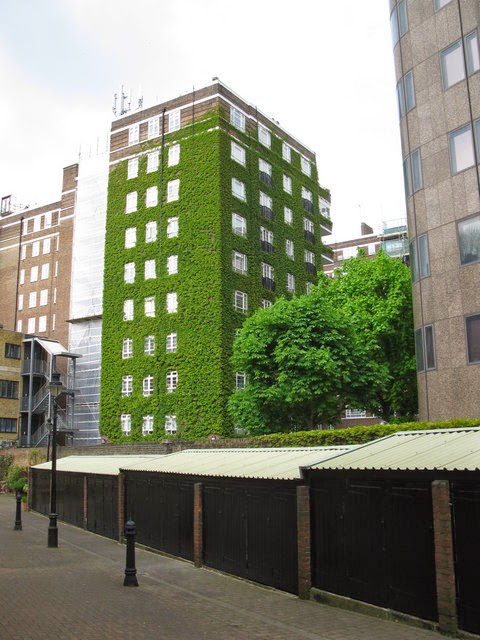What IS a Green Building? (Part I - Measurable Performance)
There is a lot of confusion on what the
definition of a “Green
Building
One common problem across all industries striving to be more "green" is that it is difficult as a consumer and corporate user alike to clearly distinguish the claims of products or buildings on sustainable measures, unless one is to use a well developed system of metrics for gauging the actual performance of a building or product against established benchmarks. When it comes to building design and construction, the metrics are often found in a number of credible green building guides, or even codes that prescribe certain measures of performance.
One common problem across all industries striving to be more "green" is that it is difficult as a consumer and corporate user alike to clearly distinguish the claims of products or buildings on sustainable measures, unless one is to use a well developed system of metrics for gauging the actual performance of a building or product against established benchmarks. When it comes to building design and construction, the metrics are often found in a number of credible green building guides, or even codes that prescribe certain measures of performance.
There are a number
of systems available to define “greenness”, and without jumping into a detailed comparison of all the systems out there today, we can cover the scope of the performance metrics that are often referred to in the myriad green building systems in use today. With a strong understanding of green building obstacles such as cost,
technical execution, and sustainable performance measures, liabilities can be mitigated at an early stage.
Site Impact
All buildings will have some impact on the site - anyone familiar with the site plan approval process can tell you that when a new building is proposed, the designer must satisfy the municipality that the proposed building does not cause undue impact on the municipal services. Further to that, however, buildings impact the native ecosystems that are pre-existing. Whether greenfield, brownfield, or reuse project, the new footprint, or simply the new use of the building has the potential to negatively or positively impact the natural ecosystems. To measure the impact, we often look at things like: the potential for soil erosion, the contamination of runoff water, the destruction of natural spaces, the reduction of solar exposure to sensitive species of flora, changes to traffic to and from the site, impact on the local aquifers, etc. All of these can be quantitatively assessed as a means of gauging the performance of a building.
Material Impact
The materials used in constructing a building contribute to the overall sustainability of the design in the following ways: waste generated in manufacturing the materials, waste generated in shipping the materials, waste generated in installing the materials, embodied energy in producing the materials, chemical composition of the materials, insulation performance of materials used in the shell, etc. Material selection with these impacts in mind can help focus the designer and constructor on certain selected performance targets to reduce the overall impact of the materials.
Water Impact
Water uses for the building could be related to process or service loads, but either way the building is likely to have some impact on local water consumption. Water diverted from storm systems to be infiltrated locally, water can be captured locally from precipitation for use in the building, water can be treated and reused locally, low consumption fixtures and processes can reduce overall demand on water. Again, it is key to find measurable metrics for water impact so that the performance of the building can be quantified.
Energy Impact
Energy consumption often gets the lion's share of the focus when it comes to green buildings, and probably deserves its own blog. For the time being tho, energy impacts from users, building systems, and building processes have huge impacts on the energy infrastructure. Reductions in electrical, natural gas, and other energy sources is typically the first priority in green design, and quite often the most cost effective impact to try to reduce. Reductions in demand cannot be quantified, however, without a baseline, and that's where it gets tricky. We will get to that next week.
Operational Impact
Prius drivers can attest to this: the way you drive your vehicle often has a significant impact on the fuel efficiency. The same holds true for buildings. An expertly designed and constructed building can miss out on performance savings by the poor use or operation of the facility. Ongoing performance evaluation, coupled with feedback and training is the typical approach to strive for continuously improving performance of the building.
Occupational Impact
The natural light quality, thermal comfort of occupants, indoor air quality, ease of use, programming, and layout of the building all contributes to how happy the building's occupants are. The happier they are, the more benefit people are getting from the building. This often contributes to lessened absenteeism, better overall health of occupants, increased rentability and lease rates, increased asset value, etc. There are a number of studies that quantify these benefits (with some debate), and could be a good topic for future discussion.
Decommissioning Impact
What happens to the building at the end of its servicable life has a huge impact as well. Today's abatement contractors make their living off of the mistakes of previous generations' design approach. Our goal in constructing a green building should give due consideration to the demolition, adaptive reuse, and/or decommissioning of the facility for lessened impact.
Societal Impact
Some green building systems like to consider what impact the building has on the local society; Does the building contribute to the teaching of others about sustainable design? Does the building use moral and sustainable procurement practices during construction? Does the building serve the needs of the local economy, or will it be underutilized? Does the building integrate with local transit infrastructure?
So, generally speaking, the key to all this is to find and track measurable performance of the building in order to gain quantitative evaluation of the design and construction of the building. Next week, we will continue our investigation what makes a building "green" by evaluating common benchmarking practices. Without benchmarking, there is little to no value in the quantification of the building performance.




Thank you for sharing the information. Green building is a been a boon to every builder as it is helping a lot in the protection of environment. I would like to tell that I have recently found a firm called logical green institute who is providing the service of green building videos.
ReplyDeleteLeed Educational Video